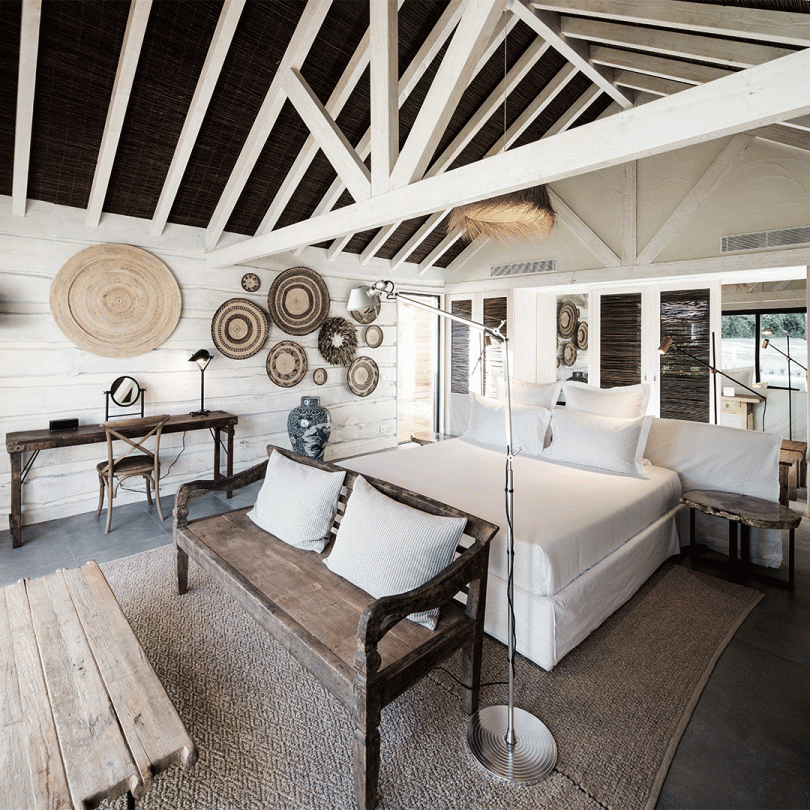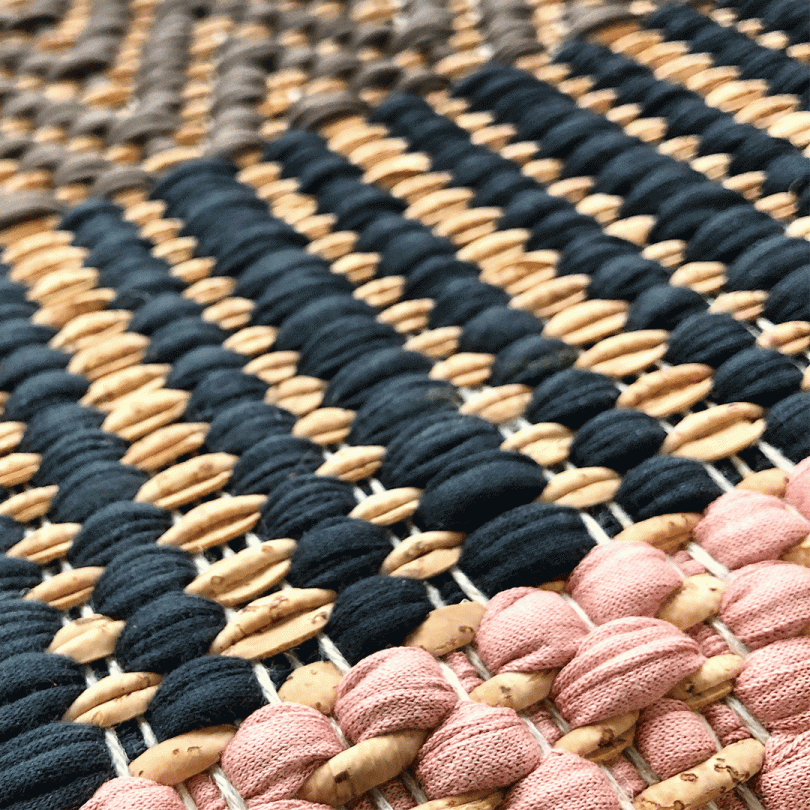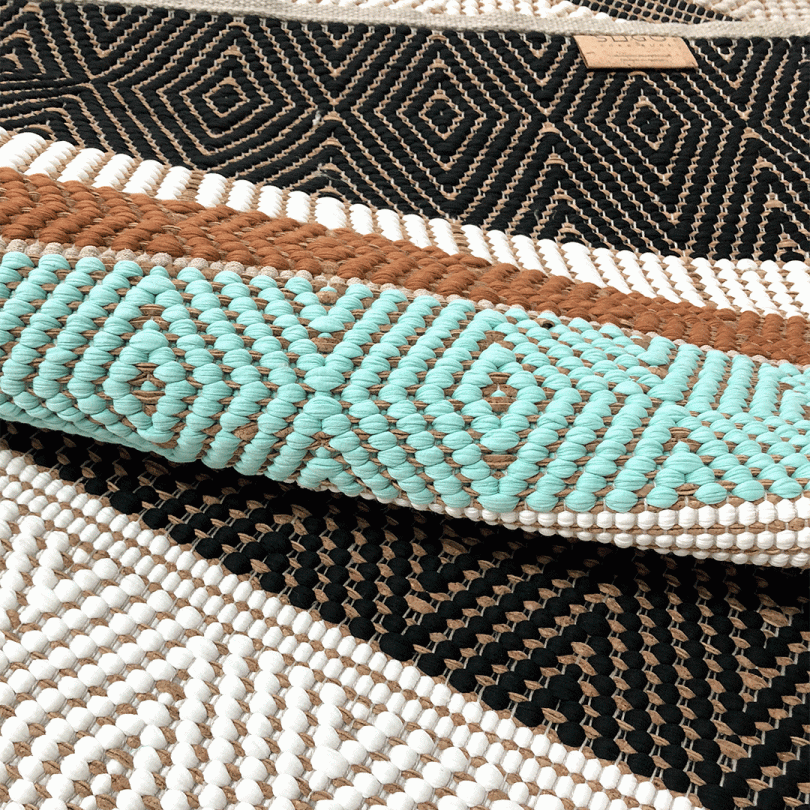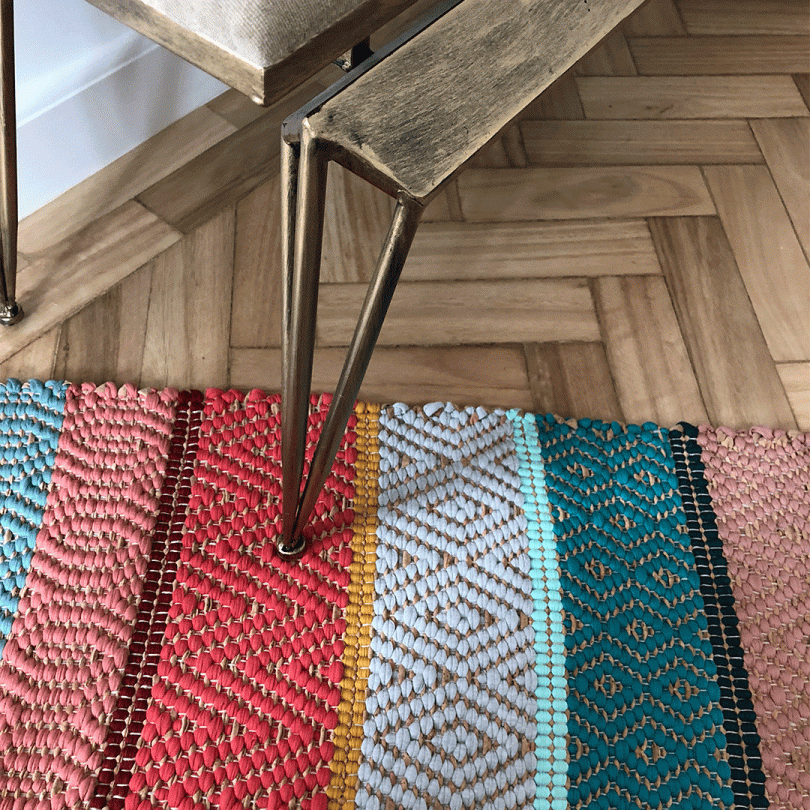The circular economy is a proposed alternative to our traditional ‘take, make, waste’ model of production and consumption – one that offers hope in the face of environmental catastrophes from climate change to ocean plastic. Designing out waste and pollution, keeping materials and products in use and regenerating our natural environment are so important to contemporary design that we wanted to create a dedicated space for the projects bringing these ideas to life. Circular by Design, a new fortnightly column by longtime contributor Katie Treggiden, will start by exploring the potential of waste as a valuable new raw material.
Portuguese designer Susana Godinho established Sugo Cork Rugs in 2017. Using contemporary design to inject life into traditional weaving techniques, she combines the performance of highly sustainable cork with recycled and recovered fabrics from the fashion and textiles industries. Based in the North of Portugal, the brand is committed to not only working in harmony with the natural world but also providing employment opportunities for people living with disabilities.
Tell me a little bit about your childhood, education, and background in terms of how you first became interested in creativity, design, and sustainability.
I was born in a small village near the sea, 20 minutes from Oporto. As my parents were very young when I was born, we lived with my grandparents. My grandfather was an excellent tailor and he worked from home. His work must have affected my childhood and education because I ended up studying textile and fashion design. He was, without doubt, the major influence on my life and he only left us recently at almost 99 years old.
How would you describe Sugo Cork Rugs?
Sugo Cork Rugs are traditionally hand-woven rugs with a contemporary design, differentiated by the use of an innovative cork solution and waste textiles in a manufacturing process that brings artisan weaving techniques back to life. Cork is a natural, renewable and very sustainable material. It is light, moisture-proof, extremely flexible, absorbs heat and sound, is hypoallergenic and soft to the touch. It is the perfect material to combine with waste textiles to make high-quality rugs.
What inspired this project?
My favorite skill in my degree was weaving, so I went straight into the rug industry when I graduated and I have worked in the textile industry for almost 20 years now. Weaving is a constant challenge and tapestry captured my imagination because it showcases weaving on a bigger scale. After all these years of experience in the rug industry, during which I have mostly worked with natural and recycled materials, the opportunity came about to introduce a new, and very Portuguese, material – cork.
What are the rugs made from, how did you select those particular materials and how do you source them?
The rugs combine cork and raw linen with recovered and recycled cotton, jersey knit and elastane from large industrial productions – such as the swimming costume offcuts we used in our All The Way collaboration with Ligne Roset. We work closely with our suppliers to ensure a fully rounded ethical process. Our cork is supplied by the world’s largest cork company, the Amorim Group, whose activities are crucial to the sustainable management of Portugal’s cork oak forests and the best environmental and social practices.
When did you first become interested in using fashion waste as raw material and what motivated this decision?
I have always worked with wasted cotton, so it’s a natural feeling for me – I look at it as a normal material. I also worked for many years in the fashion industry, mostly in knitting garments, so these kind of waste materials are really familiar – I look at them as any other materials but in smaller sizes or quantities.
What processes does the material have to undergo to become the finished product?
We have a special process to transform the cork into a format which can be introduced to the loom. The jersey is cut into strips and we spin the bouclé or loop cotton into a new kind of yarn from weaving leftovers. These yarns are then threaded onto the loom and woven into rugs using traditional weaving techniques, following contemporary designs.
How did you feel the first time you saw the transformation from waste material to product/prototype?
This material is so familiar that I look at it as a normal material, so the outcome wasn’t that surprising to me. The real difference is the reduction in waste quantities or cutting edges.
What happens to the rugs at the end of their lives? Can they go back into the circular economy?
Yes, absolutely – in fact, the Ushuaia rug was made from one of the first rugs I originally weaved 18 years ago. That piece had a little accident and was ruined, so I used almost all the jersey material to create a new one.
How have people reacted to the rugs?
The reaction has been great, especially in the last two years as people are becoming more focused on sustainable and eco-materials. But I think my design signature – using graphic details or color-blocks in a classic type of weaving – attracts people too. That and the insertion of the cork in the rugs, which results in a unique and innovative product. Of course, they meet an interior design trend at the moment, so many people come to us exactly for that – we try to stay committed to our cause by creating a product that respects the environment from several perspectives, allied with good practices.
How do you feel opinions towards waste as a raw material are changing?
If you had told me some years ago that luxury and 5-star hotels and resorts would specify rugs made from cork and cotton waste, I will not have believed you. But now it happens – and frequently. Interior designers come to us looking for a concept and a story to tell their special clients. We have proven that you can have quality, design and innovation using waste, raw and ecological materials while being friendly towards the planet and our health. My only question is why this didn’t happen decades ago?
What do you think the future holds for waste as a raw material?
It’s a worldwide trend, not only in fashion or textiles and I think it will become more and more prevalent. We have to act to protect our planet – we are all receiving the signals that we need to change our lives, our habits and practices. We do not need to be extreme, we only need to be more conscious and it will come naturally.
from WordPress https://connorrenwickblog.wordpress.com/2020/06/23/circular-by-design-susana-godinho-turns-offcuts-cork-into-rugs/














No comments:
Post a Comment